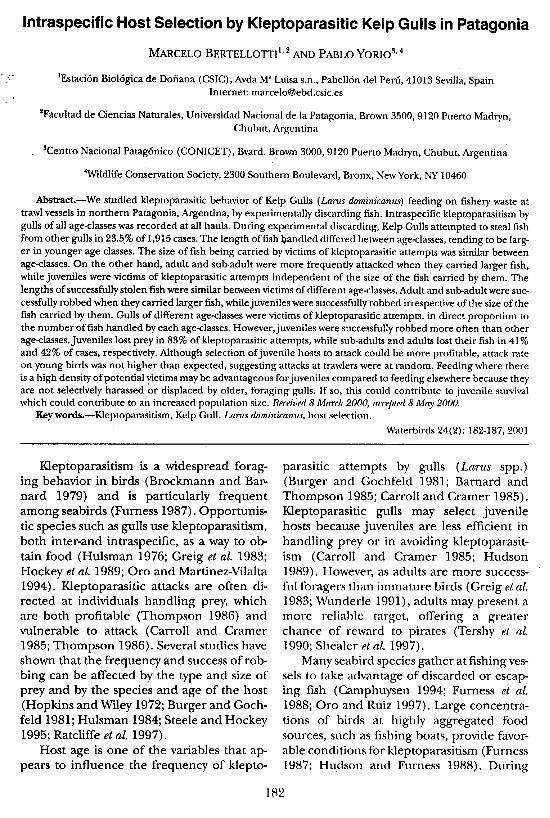Mostrar el registro sencillo del ítem
dc.contributor.author
Bertellotti, Néstor Marcelo

dc.contributor.author
Yorio, Pablo Martin

dc.date.available
2020-03-13T19:33:18Z
dc.date.issued
2001-12
dc.identifier.citation
Bertellotti, Néstor Marcelo; Yorio, Pablo Martin; Intraspecific host selection by kleptoparasitic Kelp Gulls in Patagonia; Waterbird Society; Waterbirds; 24; 2; 12-2001; 182-187
dc.identifier.issn
1524-4695
dc.identifier.uri
http://hdl.handle.net/11336/99552
dc.description.abstract
We studied kleptoparasitic behavior of Kelp Gulls (Larus dominicanus) feeding on fishery waste at trawl vessels in northern Patagonia, Argentina, through experimental discarding of fish. Intraspecific kleptoparasitism involved gulls of all age-classes and was recorded at all hauls. During experimental discarding, Kelp Gulls attempted to steal fish from other gulls in 23.5% of 1,915 cases. The length of fish handled differed between age-classes, being larger for younger age classes. The size of fish carried by victims of kleptoparasitic attempts was similar between age-classes. On the other hand, adult and sub-adult were more frequently attacked when they carried larger fish, while juveniles were victims of kleptoparasitic attempts independent of the size of the fish carried by them. The lengths of successfully stolen fish were similar between victims of different age-classes. Adult and sub-adult were successfully robbed when they carried larger fish, while juveniles were successfully robbed irregardless of the size of the fish carried by them. Gulls of different age-classes were victims of kleptoparasitic attempts, as expected according to the number of fish handled by each age-classes. However, juveniles were successfully robbed more often than other age-classes. Juveniles lost prey in 83% of kleptoparasitic attempts, while sub-adults and adults lost their fish in 41.0 and 41.5% of cases, respectively. Although selection of juvenile hosts could be more profitable, attack rate on young birds was not higher than expected, suggesting attacks at trawlers are random. This context of high density of potential victims may be advantageous for juveniles compared to other feeding habitats because they are not particularly harassed or displaced by older, foraging gulls. If so, this could contribute to juvenile survival which would greatly increase population size.
dc.format
application/pdf
dc.language.iso
eng
dc.publisher
Waterbird Society

dc.rights
info:eu-repo/semantics/openAccess
dc.rights.uri
https://creativecommons.org/licenses/by-nc-sa/2.5/ar/
dc.subject.classification
Ecología

dc.subject.classification
Ciencias Biológicas

dc.subject.classification
CIENCIAS NATURALES Y EXACTAS

dc.title
Intraspecific host selection by kleptoparasitic Kelp Gulls in Patagonia
dc.type
info:eu-repo/semantics/article
dc.type
info:ar-repo/semantics/artículo
dc.type
info:eu-repo/semantics/publishedVersion
dc.date.updated
2020-02-11T17:52:59Z
dc.journal.volume
24
dc.journal.number
2
dc.journal.pagination
182-187
dc.journal.pais
Estados Unidos

dc.journal.ciudad
Florida
dc.description.fil
Fil: Bertellotti, Néstor Marcelo. Consejo Nacional de Investigaciones Científicas y Técnicas. Centro Científico Tecnológico Conicet - Centro Nacional Patagónico; Argentina
dc.description.fil
Fil: Yorio, Pablo Martin. Consejo Nacional de Investigaciones Científicas y Técnicas. Centro Científico Tecnológico Conicet - Centro Nacional Patagónico; Argentina
dc.journal.title
Waterbirds

dc.relation.alternativeid
info:eu-repo/semantics/altIdentifier/url/https://waterbirds.org/journal/
Archivos asociados
